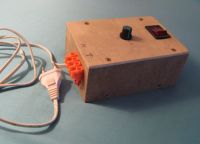Hello, it looks like this engine is adapted to the inverter for 3 phases, but you can not connect it directly to the so-called force because you will burn it, you can not exceed the interfacial voltage of 195V, its speed is affected by frequency, brown white gray is 3 phases and two black tacho you have to wander such a transducer which from 220 V one phase will make you three, .a frequency = [revolutions] would be on the potentiometer, it's quite complicated what I write but similar power systems are used in cooling evaporator fans powered by 12 V is popularly called the fact that the converter located in the motor generates a rotating magnetic field as to the voltage it produces, it is impossible to check if the motor has open photo covers, I could send you such a converter after taking a photo. I will not be able to run it now because it has a processor and I did not copy programs from other converters, if you look for it, they are definitely separate modules
PS Oh crap, this is how 220V air conditioning compressors work and they have external inverters to change the speed [efficiency] after all, on 3 power cables there is no option to start it without a capacitor, it's a different generation




